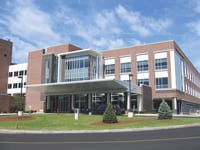Researchers Continue to Make Advances in Cancer Care
What’s Next in Treatment Options
By John Sheldon, M.D.
Cancer is the second-leading cause of death in the U.S., but we continue to make significant advances in reducing its toll.
Key developments have included targeted drug therapies resulting from genomic profiling of tumor samples, which determines the molecular ‘fingerprint’ of the tumor; immunotherapy, which allows the body’s own natural immune system to better attack tumors; more sophisticated radiation-delivery technologies, which allow for more precise targeting of tumors and better sparing of adjacent normal tissues from radiation dose; and newer combination or ‘multi-modality’ treatment regimens, taking advantage of a combination benefit effect of different ways of attacking and killing tumor cells.
In lung-cancer treatment, for example, we now have drugs to target a variety of specific mutations that may be present, such as EGFR, ALK, ROS1, MET, RET, BRAF, or NTRK. Immunotherapy has been shown to provide a survival improvement in both stage-3 and stage-4 lung cancer. For earlier and smaller lung cancers, highly targeted radiation treatment can be delivered in a short regimen of just three to five sessions, as an alternative to surgery for patients who are not good surgical candidates. And for other patients, combination regimens of radiotherapy and chemotherapy followed by immunotherapy may be the preferred approach.

“Cancer is the second-leading cause of death in the U.S., but we continue to make significant advances in reducing its toll.”
Even newer types of drugs are now available called antibody-drug conjugates, or ADCs, which target with high affinity a particular protein expressed on the surface of tumor cells, attach to the target, and then deliver a toxic payload to kill those particular tumor cells. This type of treatment was just approved by the FDA in April for metastatic ‘triple-negative’ breast cancer (a more aggressive type of breast cancer), and another drug in this category was approved last December for locally advanced or metastatic bladder cancer.
Molecularly targeted radiation delivery is another category of treatment that is advancing. Also known as peptide-receptor radiotherapy (PRRT), it consists of a radioactive particle, or radionuclide, linked to a protein, and this protein seeks out and targets its intended receptor, which is overexpressed on certain tumor cells. Once the protein-receptor binding takes place, the radionuclide is internalized into the tumor cell — and destroys the tumor cell. This treatment is currently being utilized for neuroendocrine tumors of the abdomen (the type of cancer that afflicted both Steve Jobs and Aretha Franklin), and it is being investigated for the treatment of metastatic prostate cancer.
Quality of life is an ongoing focus of cancer care, and while we always aim to increase survival, we simultaneously aim to optimize quality of life for patients under our care. In the realm of radiation treatment, shorter course regimens are more frequently being used (supported by evidence from clinical trials) in order to increase convenience for patients. Such regimens are now commonly used in the treatment of breast cancer, for early-stage lung cancer (as mentioned above), for some brain-tumor patients, and for some patients with prostate cancer. For the latter, radioactive seed implants into the prostate gland may be an option for a one-visit outpatient treatment.
In short, we continue to push forward strongly in the treatment of a broad range of cancers.
Dr. John Sheldon is medical director, Radiation Oncology at the Mass General Cancer Center at Cooley Dickinson Hospital.




